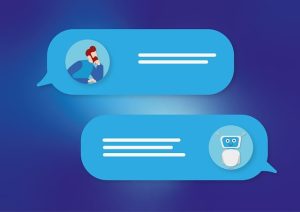In the ever-evolving landscape of digital interaction, chatbots have emerged as powerful tools, revolutionizing the way businesses engage with their audience. Let’s delve into the world of chatbot, exploring its types, benefits, functionality, and notable examples across diverse industries.
Understanding Chatbots: A Technological Marvel
Chatbots, at their core, are sophisticated computer programs designed to mimic human conversation, employing text or voice interactions. Fueled by artificial intelligence (AI) and natural language processing (NLP), these technological marvels comprehend and respond to user queries seamlessly. Their applications span across industries such as banking, insurance, media, e-commerce, airlines, hotels, retail, healthcare, and government entities.
Types of Chatbots
- Scripted or Quick Reply Chatbots:
- Interaction relies on predefined questions.
- Progression continues until the bot addresses user queries.
- AI-Powered Chatbots:
- Leverage machine learning algorithms for more accurate responses.
- Continuously learn and enhance responses based on previous interactions.
- Hybrid Chatbots:
- Combine scripted and AI-powered responses.
- Deliver a personalized user experience.
The Business Edge: Benefits of Integrating Chatbots
Chatbots bring a plethora of advantages to the business landscape, reshaping the way companies operate and interact with their audience.
Cost-Effectiveness:
- A one-time investment that surpasses the efficiency of cross-platform apps.
- Mitigates costly issues arising from human error.
Consumer Data Analysis:
- Gathers feedback to refine services, products, and website optimization.
- Records user data, offering valuable insights for marketing strategies.
Global Scalability:
- Addresses customer concerns on a global scale.
- Adapts seamlessly to different languages and markets.
Enhanced Customer Experience:
- 24/7 customer support for faster resolutions.
- Personalizes conversations and provides tailored recommendations.
The Mechanics: How Chatbots Operate
Primarily employed on business websites, chatbots enhance the user experience by offering prompt responses. They are also integrated into messaging apps, mobile apps, phone lines, and voice-enabled applications. Utilizing NLP, chatbots parse inputs and generate responses, with modern versions incorporating AI and ML to continually improve their understanding of human conversation.
Real-World Applications: Examples Across Industries
Chatbots have found their footing in various sectors, showcasing their adaptability and effectiveness.
Healthcare:
- Assist in scheduling appointments and providing medication information.
- Aid patients in locating the nearest hospital.
Retail:
- Offer product recommendations and personalized shopping experiences.
- Address customer queries in real-time.
Banking:
- Act as intelligent agents, answering customer questions and handling transactions.
- Provide financial advice and account-related information.
E-commerce:
- Deliver customer support, personalized recommendations, and order tracking assistance.
Enhancing User Interaction: Various Methods to Integrate Chatbots Seamlessly
Integrating chatbots into a website or app is a versatile process, offering different approaches based on the platform and chatbot type. Discover the following techniques to seamlessly incorporate chatbots into your digital presence:
1. Crafting a Chatbot Landing Page for Enhanced Interaction
Building a dedicated chatbot landing page is an effective method. This involves creating a page tailored to match the website’s branding, providing details on the chatbot’s capabilities, and offering guidance on usage. Users can effortlessly access the chatbot by clicking a designated button or link on the landing page.
2. Deploying a Pre-Programmed Chat Widget for Instant Engagement
Many websites feature pre-programmed chat widgets displaying welcome messages instead of human agents. This approach enhances sales, engagement, and more. Integration is straightforward; copy and paste a code snippet into the website’s HTML code. Customize the chat widget to align with the website’s branding and program it to respond intelligently to common user queries.
3. Leveraging Third-Party Chatbot Platforms for Effortless Integration
Explore third-party chatbot platforms designed to facilitate seamless integration into websites or apps. These platforms typically provide user-friendly, drag-and-drop interfaces, enabling businesses to create chatbots without coding expertise. Once the chatbot is configured, integration is achieved through a code snippet or API.
4. Utilizing Chatbot Development Frameworks for Tailored Solutions
For businesses with ample resources and technical proficiency, employing chatbot development frameworks is a powerful option. These frameworks furnish developers with a toolkit of tools and libraries to create customized chatbots from scratch. Integration into the website or app is then accomplished using a code snippet or API.
In summary, businesses can choose from various integration methods based on their platform and chatbot requirements. Whether opting for a dedicated landing page, pre-programmed chat widget, third-party platform, or a bespoke development framework, the integration of chatbots enhances customer experiences, reduces costs, and elevates overall engagement. Embrace the power of chatbots to transform your digital interaction landscape.
Embracing the Future: The Continued Evolution of Chatbots
As businesses increasingly recognize the cost-effectiveness, scalability, and improved customer experience offered by chatbots, the integration of these digital assistants will only intensify. With advancements in AI and ML, the sophistication of chatbots is set to grow, promising even more significant benefits for businesses across diverse sectors. The journey of chatbots continues to redefine the digital landscape, unlocking new potential for businesses willing to embrace this transformative technology.


















+ There are no comments
Add yours